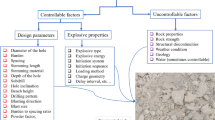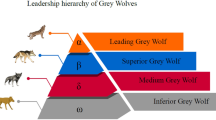Abstract
The aim of this study is to predict the peak particle velocity (PPV) values from both presently constructed simple regression model and fuzzy-based model. For this purpose, vibrations induced by bench blasting operations were measured in an open-pit mine operated by the most important magnesite producing company (MAS) in Turkey. After gathering the ordered pairs of distance and PPV values, the site-specific parameters were determined using traditional regression method. Also, an attempt has been made to investigate the applicability of a relatively new soft computing method called as the adaptive neuro-fuzzy inference system (ANFIS) to predict PPV. To achieve this objective, data obtained from the blasting measurements were evaluated by constructing an ANFIS-based prediction model. The distance from the blasting site to the monitoring stations and the charge weight per delay were selected as the input parameters of the constructed model, the output parameter being the PPV. Valid for the site, the PPV prediction capability of the constructed ANFIS-based model has proved to be successful in terms of statistical performance indices such as variance account for (VAF), root mean square error (RMSE), standard error of estimation, and correlation between predicted and measured PPV values. Also, using these statistical performance indices, a prediction performance comparison has been made between the presently constructed ANFIS-based model and the classical regression-based prediction method, which has been widely used in the literature. Although the prediction performance of the regression-based model was high, the comparison has indicated that the proposed ANFIS-based model exhibited better prediction performance than the classical regression-based model.








Similar content being viewed by others
References
Akbulut S, Hasiloglu AS, Pamukcu S (2004) Data generation for shear modulus and damping ratio in reinforced sands using adaptive neuro-fuzzy inference system. Soil Dyn Earthq Eng 24:805–814
Akeil S (2004) Comparative study on ground vibrations prediction by statistical and neural networks approaches at Tuncbilek Coal Mine [in English]. Panel BYH. M.Sc., Middle East Technical University, Turkey
Ambraseys NR, Hendron AJ (1968) Dynamic behavior of rock masses: rock mechanics in engineering practices. Wiley, London, pp 203–207
Duvall WI, Fogleson DE (1962) Review of criteria for estimating damage to residences from blasting vibration. U.S. Bureau of Mines R.I. 5968
Erentoz C (1963) 1/500,000 scaled geological map of Turkey, Ankara sheet, MTA
Ghosh A, Daemen JK (1983) A simple new blast vibration predictor of ground vibrations induced predictor: 24th US symposium on rock mechanics, Texas
Gokceoglu C (2002) A fuzzy triangular chart to predict the uniaxial compressive strength of Ankara agglomerates from their petrographic composition. Eng Geol 66:39–51
Gokceoglu C, Zorlu K (2004) A fuzzy model to predict the uniaxial compressive strength and the modulus of elasticity of a problematic rock. Eng Appl Artif Intell 17(1):61–72
Gokceoglu C, Yesilnacar E, Sonmez H, Kayabasi A (2004) A neuro-fuzzy model for modulus of deformation of jointed rock masses. Comput Geotech 31(5):375–383
Gozler MZ, Cevher F, Kucukayman A, Asutay HJ (1997) Orta Sakarya ve guneyinin jeolojisi [in Turkish]. MTA report no. 9973, Ankara
Grima MA (2000) Neuro-fuzzy modelling in engineering geology. A. A. Balkema, Rotterdam, 244 pp
Grima MA, Babuska R (1999) Fuzzy model for the prediction of unconfined compressive strength of rock samples. Int J Rock Mech Min Sci 36(3):339–349
Grima MA, Bruines PA, Verhoef PNW (2000) Modeling tunnel boring machine performance by neuro-fuzzy methods. Tunn Undergr Space Technol 15(3):260–269
Habibagahi G (2002) Post-construction settlement of rockfill dams analyzed via adaptive network-based fuzzy inference systems. Comput Geotech 29(3):211–233
Hustrulid W (1999) Blasting principles for open pit mining, vol 1. A. A. Balkema, Rotterdam, pp 269–292
Jang RJS (1993) Anfis: adaptive-network-based fuzzy inference system. IEEE Trans Syst Man Cybern 23:665–685
Jang RJS, Sun CT, Mizutani E (1997) Neuro-fuzzy and soft computing. Prentice-Hall, Upper Saddle River, 614 pp
Kahriman A (2002) Analysis of ground vibrations caused by bench blasting at can open-pit lignite mine in Turkey. Environ Geol 41(6):653–661
Kahriman A, Ozer U, Aksoy M, Karadogan A, Tuncer G (2006) Environmental impacts of bench blasting at Hisarcik Boron open pit mine in Turkey. Environ Geol 50(7):1015–1023
Khandelwal M, Singh TN (2006) Prediction of blast induced ground vibrations and frequency in opencast mine: a neural network approach. J Sound Vibr 289(4–5):711–725
Khandelwal M, Singh TN (2007) Evaluation of blast-induced ground vibration predictors. Soil Dyn Earthq Eng 27(2):116–125
Kisi O (2005) Suspended sediment estimation using neuro-fuzzy and neural network approaches. Hydrol Sci J 50(4):683–696
Kuzu C, Ergin H (2005) An assessment of environmental impacts of quarry-blasting operation: a case study in Istanbul, Turkey. Environ Geol 48(2):211–217
Langefors U, Kihlstrom B (1978) The modern technique of rock blasting. Willey, New York, p 405
Lu Y (2005) Underground blast induced ground shock and its modelling using artificial neural network. Comput Geotech 32:164–178
Matlab (1999) The language of technical computing. The Matworks, New York
Ocakoglu F (2007) A re-evaluation of the Eskisehir fault zone as a recent extensional structure in NW Turkey. J Asian Earth Sci 31:91–103
Ozer U, Kahriman A, Aksoy M, Adiguzel D, Karadogan A (2007) The analysis of ground vibrations induced by bench blasting at Akyol quarry and practical blasting charts. Environ Geol. doi:10.1007/s00254-007-0859-7
Porwal A, Carranza EJM, Hale M (2004) A hybrid neuro-fuzzy model for mineral potential mapping. Math Geol 36(7):803–826
Rai R, Shrivastva BK, Singh TN (2005) Prediction of maximum safe charge per delay in surface mining. Min Technol (Trans Inst Min Metall A) 114(4):A227–A231
Roy PP (1991) Vibration control in an opencast mine based on improved blast vibration predictors. Min Sci Technol 12:157–165
Sawmliana C, Roy PP, Singh RK, Singh TN (2007) Blast induced air overpressure and its prediction using artificial neural network. Min Technol (Trans Inst Min Metall A) 116(2):41–48
Singh TN (2004) Artificial neural network approach for prediction and control of ground vibrations in mines. Min Technol (Trans Inst Min Metall A) 113(4):A251–A256
Singh TN, Singh V (2005) An intelligent approach to prediction and control ground vibration in mines. Geotech Geol Eng 23(3):249–262
Singh TN, Amit P, Saurabh P, Singh PK (2002) Prediction of explosive charge for efficient mining operation. Rock engineering-problems and approaches in underground construction, Seoul, 22–24 July 2002
Singh PK, Roy MP, Singh RK (2005a) Responses of roof and pillars of underground coal mines to vibration induced by adjacent open-pit blasting. Environ Geol 47(2):205–214
Singh PK, Sirveiya AK, Roy MP, Prasad A, Mohapatra T (2005b) A new approach in blast vibration analysis and prediction at iron ore mines. Min Technol (Trans Inst Min Metall A) 114(4):A209–A218
Singh TN, Kanchan R, Verma AK, Saigal K (2005c) A comparative study of ANN and Neuro-fuzzy for the prediction of dynamic constant of rockmass. J Earth Syst Sci 114(1):75–86
Singh TN, Verma AK, Singh V, Sahu A (2005d) Slake durability study of shaly rock and its predictions. Environ Geol 47(2):246–253
Singh PK, Sirveiya AK, Babu KN, Roy MP, Singh CV (2006) Evolution of effective charge weight per delay for prediction of ground vibrations generated from blasting in a limestone mine. Int J Min Reclam Environ 20(1):4–19
Tutmez B, Hatipoglu Z, Kaymak U (2006) Modelling electrical conductivity of groundwater using an adaptive neuro-fuzzy inference system. Comput Geosci 32:421–433
Tutmez B, Dag A, Tercan AE, Kaymak U (2007) Lignite thickness estimation via adaptive fuzzy-neural network. In: 20th international mining congress and exhibition of Turkey-IMCET2007, Ankara, 6–8 June 2007
Acknowledgments
The author wishes to express his gratitude to Muhsin Tugen, General Manager of MAS, for allowing us to be able to perform seismic measurements at the magnesite mine. The authors are also grateful to the mining engineers Umit Yildirim, Haydar Yilmaz, Gokhan Mertler and blasting expert Murat Kuvvetli for their kind help at the field.
Author information
Authors and Affiliations
Corresponding author
Rights and permissions
About this article
Cite this article
Iphar, M., Yavuz, M. & Ak, H. Prediction of ground vibrations resulting from the blasting operations in an open-pit mine by adaptive neuro-fuzzy inference system. Environ Geol 56, 97–107 (2008). https://doi.org/10.1007/s00254-007-1143-6
Received:
Accepted:
Published:
Issue Date:
DOI: https://doi.org/10.1007/s00254-007-1143-6




